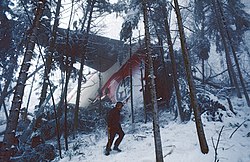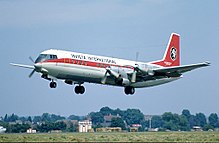 Wreckage at the crash site | |
| Accident | |
|---|---|
| Date | 10 April 1973 |
| Summary | Controlled flight into terrain |
| Site | 300 m south of the Herrenmatt hamlet, Hochwald, Switzerland 47°27′15″N 7°37′24″E / 47.45417°N 7.62333°E |
| Aircraft | |
 G-AXOP, the aircraft involved in the accident seen in 1971 at London Southend Airport. | |
| Aircraft type | Vickers Vanguard |
| Operator | Invicta International Airlines |
| IATA flight No. | IM435 |
| Call sign | INVICTA 435 |
| Registration | G-AXOP |
| Flight origin | Bristol Lulsgate Airport, England |
| Destination | Basel-Mulhouse Airport, Switzerland |
| Occupants | 145 |
| Passengers | 139 |
| Crew | 6 |
| Fatalities | 108 |
| Injuries | 36 |
| Survivors | 37 |

Invicta International Airlines Flight 435 (IM435) was a Vickers Vanguard 952, flying from Bristol Lulsgate to Basel-Mulhouse, which crashed into a forested hillside near Hochwald, Switzerland on 10 April 1973. The aircraft somersaulted and broke up, killing 108 people, with 37 survivors. To date, this is the deadliest accident involving a Vickers Vanguard and the deadliest aviation accident to occur on Swiss soil.[1] Many of the 139 passengers on the charter flight were women, members of the Axbridge Ladies Guild, from the Somerset towns and villages of Axbridge,[2] Cheddar, Winscombe and Congresbury.[3][4][5] The accident left 55 children motherless[2] and became known in the British media as the Basle air crash.[6]
Pilot Anthony Dorman became disoriented, misidentifying two radio beacons and missing another.[2] When co-pilot Ivor Terry took over, his final approach was based on the wrong beacon and the aircraft crashed into the hillside.[2] Dorman had previously been suspended from the Royal Canadian Air Force for lack of ability, and had failed his United Kingdom instrument flight rating test eight times.[7] As a result of the crash, tougher regulations were introduced in the UK.
Despite the conclusions of the official Swiss report, one commentator, ex-KLM pilot Jan Bartelski, has argued that the pilots may not have been entirely to blame and that there is a possibility that they were led off course by "ghost" beacon transmissions caused by electric power lines.[8]
- ^ "ASN Aircraft accident Vickers 952 Vanguard G-AXOP Basel/Mulhouse Airport (BSL)". Aviation Safety Network (ASN). Retrieved 20 June 2015.
- ^ a b c d Faith, Nicholas (1996). Black Box. Boxtree. p. 166. ISBN 0-7522-1084-X.
- ^ "Fatal fatigue". Time. 23 April 1973. Archived from the original on 14 December 2008.
- ^ Hansard 11 April 1973
- ^ "Report No: 11/1975. Vickers Vanguard 952, G-AXOP. Report on the accident at Hochwald/Solothurn, Switzerland, on 10 April 1973". Air Accidents Investigation Branch. 1975.
- ^ "Basle air crash: Memorial service marks 40th anniversary". BBC News. Retrieved 29 May 2022.
- ^ Forman, Patrick (1990). Flying into danger: the hidden facts about air safety. Heinemann. pp. 5, 111. ISBN 978-0-434-26864-1.
- ^ Bartelski, Jan (2001) Disasters in the Air. Airlife Publishing Ltd. pp 208–229 ISBN 1-84037-204-4